#109: Santa Elena + Early Spanish Settlement of SC, a New Voyage to Carolina, and a 12,000 Year History Park
For South Carolina history lovers far and wide! Published weekly on Monday mornings. Enjoy weekly SC history articles and upcoming SC historical events.
Dear reader,
Welcome to SC History Newsletter #109!
Before we begin on today’s topic of early Spanish settlement in South Carolina, I wanted to share that one of our most dedicated subscribers,
, wrote to me after Newsletter #107 about his experiences of Hurricane Hugo. I thought you would all appreciate his book recommendation and his personal account of the storm below — thank you for sharing, Alan!“Book recommendation! William Price Fox was a novelist, humorist, and writer-in-residence at USC for a number of years. He wrote Lunatic Wind, about Hugo and the people down along the Lowcountry who were most affected by it.
Love this topic, BTW. I was a high school senior in September, 1989. Even as far inland as Columbia, the winds were unbelievable. I had never heard anything like it before or since. Howling, almost human — or maybe demonic is a better description.
A day after the storm, my dad & I drove to Sumter to check on my grandparents. Of course no cell phones back then, and landlines were down. Sumter had been hit particularly hard - lots of spin-off tornadoes. The normally 45 minute drive from Northeast Columbia took us almost four hours because of all the downed trees, the road closures, etc. You would look off into the forest along the drive and see corridors where tornadoes had torn a path through the trees. Erie.
We finally got there, and were relieved to find them doing just fine. They had lost eight or nine pine trees. Miraculously only one had clipped a run of gutter, but otherwise the house was in good shape. They had spent a long night in a central hallway, listening to a battery powered weather radio amid the sound of "lunatic wind" and snapping pines.
I, along with a buddy who would become my brother-in-law, spent the next month of weekends going over there to cut up trees and haul them to the landfill along with everybody else in the area.”
As always, I’d like to welcome the following new subscribers to our community. Thank you for your interest in South Carolina history!
jen@scltn
psmith
New friends! If you are new to the newsletter, please note that there are over 100 previous SC History newsletters on topics ranging from the founding of Charleston, sunken Confederate submarines, railroad tunnels filled with blue cheese, and so much more! I encourage you to take a look at our archive here.
Send me your topic ideas: I love it when subscribers write to me! Have a SC History topic or question you’d like for me to write about? Just reply to this email and let me know!
Join us on social: Please join us & keep the conversation going by becoming a member of our SC History Newsletter Facebook Community here! I can’t wait to meet you. :)
If your email “cuts off”: In your email app or website, if my emails “cut off” for you, please click the title of the email and it will take you to the full post on the Substack. I don’t want you to miss any content!
And now, let’s learn some South Carolina history!
Yours truly,
Kate
(Writing from Greenville, SC)
➳ Featured SC History Events
Please note our featured SC History Event below, and click here to visit my SC History Events Calendar that organizes all the upcoming SC history events I have discovered.
Please let me know if you’d like to add an event to the calendar! Reply to this email, send me a note at schistorynewsletter@gmail.com, or use the button below to send me your events.
Event Recommendation of the Week:
Saturday, August 17th at 1:00 pm | “12,000 Year History Park – Colonial Forts Tour” | 12000 Year History Park | Cayce, SC | FREE! | Website
“In the deep woods of South Carolina, days from civilization, a little fort was built in 1718. Walk to the site of Fort Congaree and hear its intriguing stories as we delve into the struggles of the Deerskin Economy, then travel forward in time to Fort Congaree and Fort Granby. Meet in front of the Cayce Tennis Center, located at 1120 Fort Congaree Trail in Cayce. The 2-mile free history tour is about 2 hours long and sponsored by the City of Cayce.”
➳ SC History Book & Article Recommendations
“A New Voyage to Carolina” by John Lawson
(Note from Kate: This book was recommended to our readers by subscriber Larry C.! Larry wrote to me: “I took a continuing education class, Colonial History of South Carolina, at Anderson University about 10 years ago. My instructor was Dr. Bonnie Ledbetter, now aged 90, former History Faculty at Texas A&M and Clemson. One of the readings she often cited in class was ‘A New Voyage to Carolina’ by John Lawson which offers an incredible look at very early colonial inland South and North Carolina. It's a fascinating read and there is some mystery about who John Lawson was and why he was on this voyage to explore backcountry South Carolina. His journey from Charleston to the midlands may be of interest.” I am definitely adding this to my reading list! Thank you, Larry!)
Here is the publisher’s description:
“John Lawson's amazingly detailed yet lively book is easily one of the most valuable of the early histories of the Carolinas, and it is certainly one of the best travel accounts of the early eighteenth-century colonies. An inclusive account of the manners and customs of the Indian tribes of that day, it is also a minute report of the soil, climate, trees, plants, animals, and fish in the Carolinas. Lawson's observation is keen and thorough; his style direct and vivid. He misses nothing and recounts all — from the storms at sea to his impressions of New York in 1700, the trip down the coast to Charleston, and his travels from there into North Carolina with his Indian guides. The first edition of this work was published in London in 1709. While various editions followed in the eighteenth century — including two in German — this edition is a true copy of the original and is the first to include a comprehensive index. It also contains "The Second Charter" "An Abstract of the Constitution of Carolina" Lawson's will, and several previously unpublished letters written by Lawson. A number of DeBry woodcuts of John White's drawings of Indian life, sketches of the beasts of Carolina which appeared in the original 1709 edition, and Lawson's map contribute additional interest to this volume.”
Do you have a book or article on South Carolina history that has caught your attention? Reply to this email or submit here! We would love to highlight.
➳ SC History Topic of the Week:
Did you know that the Spanish were the first Europeans to settle in South Carolina?
The Coastal Discovery Museum in Hilton Head, SC is one of my favorite museums that I have often featured in the newsletter. While I have not yet visited the museum (it’s on my list!), they consistently organize exciting events that bring South Carolina history to life.
This week, I was excited to discover a Smithsonian Magazine article (link here) that advertised an upcoming exhibition at the Coastal Discovery Museum that will highlight the “untold story of Saint Helena, the first European Colonial capital in North America.” Scheduled to open in 2025, the exhibition will “showcase North America's first European colonial capital, and it invites us all to peel back the many layers of history beneath the island's surface.”
Many of us may think that the first settlers in South Carolina were of British or French descent, but in reality, the first settlers in SC from Europe were Spanish!
Today, St. Helena Island in Beaufort County, South Carolina is a rural Sea Island “that showcases the rich history of the Lowcountry both past and present.” It is part of a chain of over 100 islands off the coast of South Carolina, Georgia, and Florida that includes Hilton Head, St. Simons, and Kiawah.
Before European contact, it is important to note that there was a strong presence of Native Americans in this area. We will name a few of those tribes later on in the story of this first settlement.
In the 16th century, Spanish explorers during in the Age of Exploration began to assert their dominance over the Southeastern coast of North America and the Caribbean islands to the south. Santa Elena, as it was then called, took shape as a “powerful example of Spanish ambition in the New World."
On August 18th, 1525, the “Punta de Santa Elena” was first discovered by Spanish explorer Pedro Quejo under contract for Lucas Vázquez de Ayllón. (Note from Kate: isn't it great that the timing of this newsletter almost perfectly coincides with the discovery of Santa Elena on August 18th, 1525, which would have been 499 years ago?)
The island was named for Saint Helena because its discovery coincided with the Feast Day celebration of the saint. St Helena was the mother of Constantine the Great and is credited as discovering the “True Cross upon which Jesus Christ was crucified.” Saint Helena is also considered the patron saint of “difficult marriages, divorced people, converts, and archaeologists.”
But how did the Spanish explorers arrive at Santa Elena in the first place and who was Lucas Vázquez de Ayllón, who sponsored this first expedition to the area?
Lucas Vázquez de Ayllón was born in 1480 in Toledo, Spain and was a prominent judge. In 1504, Ayllón arrived in the Spanish colony of Hispaniola. He served as a district judge, gaining power and authority over time until he sat on the region's highest appeals court. Soon, Ayllón owned estates and property, as well as “trading and slaving ventures.”
In 1521, Ayllón sponsored a exploration/slaving expedition that took his men up the Southeastern coast to Winyah Bay, of present-day South Carolina. The men explored the area, and also encountered Native Americans — 60 of which they enslaved and brought back to Hispaniola.
One of the enslaved Native Americans was a man who would later be baptized and named Francisco de Chicora. Back in Hispaniola, he became Lucas Vázquez de Ayllón’s slave and told the judge wondrous stories of his beautiful and prosperous homeland (modern-day South Carolina), which he referred to as Chicora.
Armed with the tales of his slave, and the first-hand accounts of his men from their recent expedition, Ayllón traveled to Spain to convince the Spanish crown to support him in the conquest and exploration of the Southeastern coast of North America.
According to the South Carolina Encyclopedia, in June of 1523, Charles V granted Ayllón a contract to establish a Spanish presence in the region from “thirty five to thirty seven degrees north latitude…The contract named Ayllón governor of the colony and granted him a range of privileges in exchange for funding and carrying out this expedition.”
In July 1526, Ayllón assembled an expedition of 600 people (including Francisco de Chicora, who served as a translator and guide) to venture back to the land of his slave. They landed in Winyah Bay, and founded the town of San Miguel de Guadalupe in September 1526.
The town’s name likely came from its founding on or around September 29, the feast day of St. Michael the Archangel.
San Miguel de Guadalupe became the first European municipality in North America.
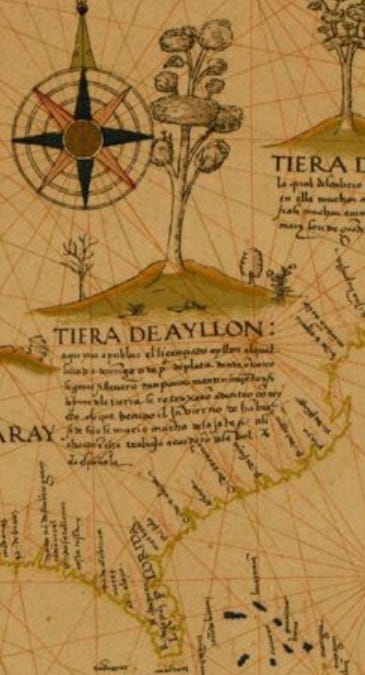
Of the 600 original residents, among them were “sailors, Spanish colonists (including women and children), several priests, and an unknown number of African slaves.”
The settlers constructed houses, a church, and “established the institutions of government there.” However, supplies in the colony were scarce, “due to the loss of the expedition’s flagship and its cargo.”
In these harsh conditions, San Miguel’s residents soon began to fall ill and die, including the founder of the settlement Lucas Vázquez de Ayllón himself. He died within the first few weeks of the settlement.
After Ayllón’s death, some of the Spanish settlers “mutinied and imprisoned the town’s authorities.” Destruction and chaos ensued.
The African slaves “set fire to the mutiny leader’s house, and nearby Indians killed some colonists who attempted to steal their food.”
By mid-November 1526, the San Miguel settlement was abandoned. Of the expedition’s initial 600 participants, only 150 survived.
Interestingly, the settlement of San Miguel de Guadalupe is a site that is still undiscovered by archaeologists to this day.
Despite the failure of the San Miguel de Guadalupe colony, stories of Ayllón and his slave Francisco to Chicora describing the wonders of his homeland “found their way into the writings of the chronicler Peter Martyr and circulated throughout Europe.” Europeans could still see the promise of this beautiful and mysterious land.
Interesting side note related to the bullet above: Peter Martyr d'Anghiera, formerly known in English as Peter Martyr of Angleria, was an Italian historian “at the service of Spain during the Age of Exploration.” He wrote the first accounts of explorations in Central and South America in a series of letters and reports, grouped in the original Latin publications of 1511 to 1530 into sets of ten chapters called "decades." His Decades of the New World are “of great value in the history of geography and discovery.” His De Orbe Novo (On the New World, 1530) describes the first contacts of Europeans and Native Americans, Native American civilizations in the Caribbean and North America, as well as Mesoamerica, and includes, for example, the first European reference to India rubber. It was first translated into English in 1555, and in a fuller version in 1912.
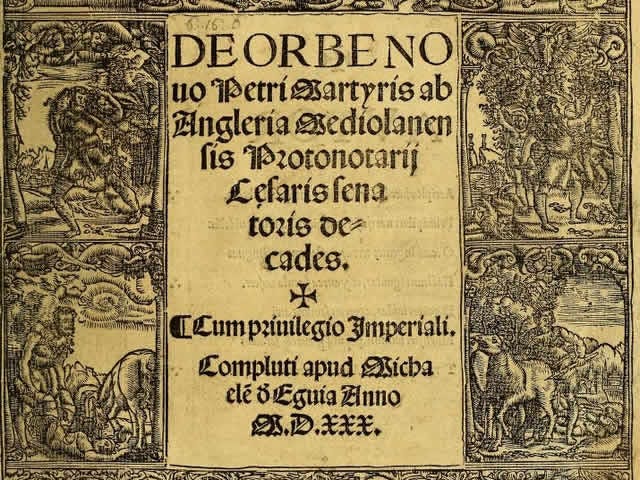
I was able to find the image above and translated excerpts from Peter Martyr’s writings and wanted to share some here. Certainly, these writings would have captured the European imagination!
“I must cite another witness whose credit is not less among laymen than that of Dean Alvares amongst priests, namely the licenciate Lucas Vasquez Ayllon. He is a citizen of Toledo, member of the Royal Council of Hispaniola, and one of those at whose expense the two ships had been equipped. Commissioned by the Council of Hispaniola to appear before the Royal India Council, he urgently asked that he might be permitted to again visit that country and found a colony. He brought with him a native of Chicorana as his servant. This man had been baptised under the Christian name of Francisco united to the surname of his native country, Chicorana. While Ayllon was engaged on his business here, I sometimes invited him and his servant Francisco Chicorana to my table. This Chicorana is not devoid of intelligence. He understands readily and has learned the Spanish tongue quite well. The letters of his companions which the licenciate Ayllon himself showed to me, and the curious information furnished me by Chicorana, will serve me for the remainder of my narrative. Each may accept or reject my account as he chooses…
Leaving the coast of Chicorana on one hand, the Spaniards landed in another country called Duhare. Ayllon says the natives are white men, and his testimony is confirmed by Francisco Chicorana. Their hair is brown and hangs to their heels. They are governed by a king of gigantic size, called Datha, whose wife is as large as himself. They have five children. In place of horses, the king is carried on the shoulders of strong young men, who run with him to the different places he wishes to visit. At this point, I must confess, that the different accounts cause me to hesitate. The Dean and Ayllon do not agree; for what one asserts concerning these young men acting as horses, the other denies. The Dean said: ‘I have never spoken to anybody who has seen these horses,’ to which Ayllon answered, “I have heard it told by many people,’ while Francisco Chicorana, although he was present, was unable to settle this dispute. Could I act as arbitrator, I would say that, according to the investigations I have made, these people were too barbarous and uncivilised to have horses. Another country near Duhare is called Xapida. Pearls are found there, and also a kind of stone resembling pearls which is much prized by the Indians.
In all these regions they visited, the Spaniards noticed herds of deer similar to our herds of cattle. These deer bring forth and nourish their young in the houses of the natives. During the daytime they wander freely through the woods in search of their food, and in the evening they come back to their little ones, who have been cared for, allowing themselves to be shut up in the courtyards and even to be milked, when they have suckled their fawns. The only milk the natives know is that of the does, from which they make cheese. They also keep a great variety of chickens, ducks, geese, and other similar fowls. They eat maize-bread, similar to that of the islanders, but they do not know the yucca root, from which cassabi, the food of the nobles, is made. The maize grains are very like our Genoese millet, and in size are as large as our peas. The natives cultivate another cereal called xathi. This is believed to be millet but it is not certain, for very few Castilians know millet, as it is nowhere grown in Castile. This country produces various kinds of potatoes, but of small varieties. Potatoes are edible roots, like our radishes, carrots, parsnips, and turnips. I have already given many particulars, in my first Decades, concerning these potatoes, yucca, and other foodstuffs.”
While temporary abandoned, the land of the San Miguel settlement wouldn’t lay dormant for long…
40 years later in 1562, a French naval officer named Jean Ribault returned to the area of Punta de Santa Elena and San Miguel de Guadalupe. He renamed the harbor Port Royal and established a fort on modern-day Parris Island known as Charlesfort, claiming the land for France. However, due to lack of supplies, the fort was abandoned shortly thereafter.
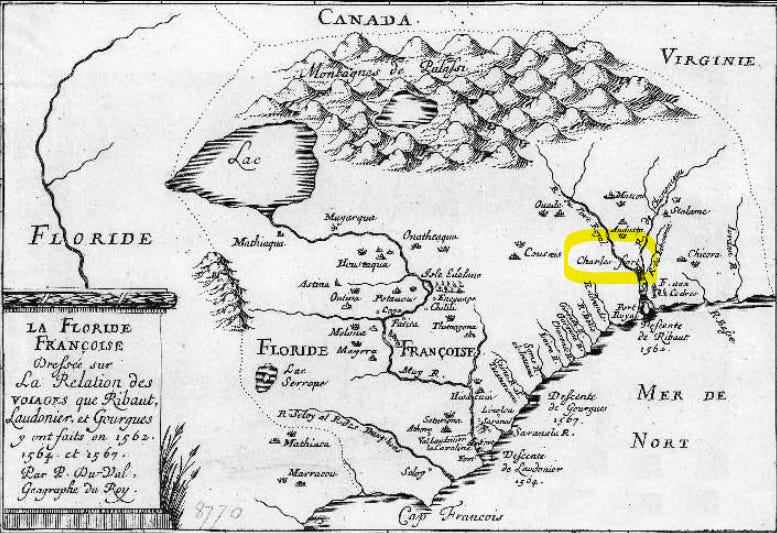
In 1566, the Spanish returned! The settlement of Santa Elena was formally founded by Spanish admiral Pedro Menéndez de Avilés. Avilés had conquered the Frenchman Ribault’s forces and set up Santa Elena as a strategic foothold for Spain once again.
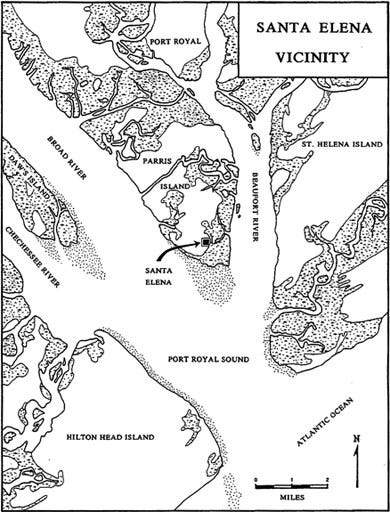
Rex Garniewicz, President and CEO of the Coastal Discovery Museum, describes the historical significance of Santa Elena:
“One of the fascinating things, if you look at Santa Elena, is that the entire northern hemisphere was connected at this spot…This was 200 years before the American Revolution, and there were approximately 500 plus Spaniards living in this province of La Florida, which stretched from Newfoundland all the way to Mexico. Santa Elena was the capital, and was the first colonial capital in what’s now the United States…very few people know that.”
The location of Santa Elena quickly became a hotbed of European power struggles. These struggles necessitated the building of forts to protect the region. Over a 20-year period, the Spanish built 4 forts at this location.
Additionally, it was not an easy place to live. According to the Smithsonian Magazine, "It was hardly smooth sailing for the fledgling settlement, as poor resupply lines and low crop yields ultimately drove many of the settlers away, leaving it vulnerable to attack "
Rex Garniewicz also describes the geographic importance of the settelement:
“[The Spanish] intended to settle Santa Elena and then find overland routes to Mexico and expand their holdings across all of North America. It was a very directed effort…[Santa Elena’s location] was also critical for the Spanish fleets bringing gold and silver from mines in Peru and Mexico back to Spain; they wanted to follow the Gulf Stream up until the point where they could catch the Westerlies across the Atlantic. That point happens to be at Point Royal Sound.”
The ships Garniewciz describes above that carried gold and silver were ideal targets for English and French ships — along with pirates — to loot.
Troubles continued in Santa Elena in 1576 when the local Native American people of the region — including the Orista, Guale, and Escamacu tribes — banded together to drive out the Spanish. Their attack resulted in the temporary abandonment of the settlement, but the Spanish returned to protect the land from the French and double down on Santa Elena’s strategic importance.
However, the following year in 1587, the Spanish finally abandoned Santa Elena and consolidated their power to the settlement of St. Augustine in Florida.
Before the mid-20th century, little was known about this early Spanish occupation of the South Carolina territory. Archaeological excavations began as early as 1850, but many researchers thought that the Santa Elena site was French rather than Spanish. Researchers consulted illustrations drawn by Jacques Lemoyne during Ribault’s French control of Charlesfort and were not aware of the earlier Spanish influence.
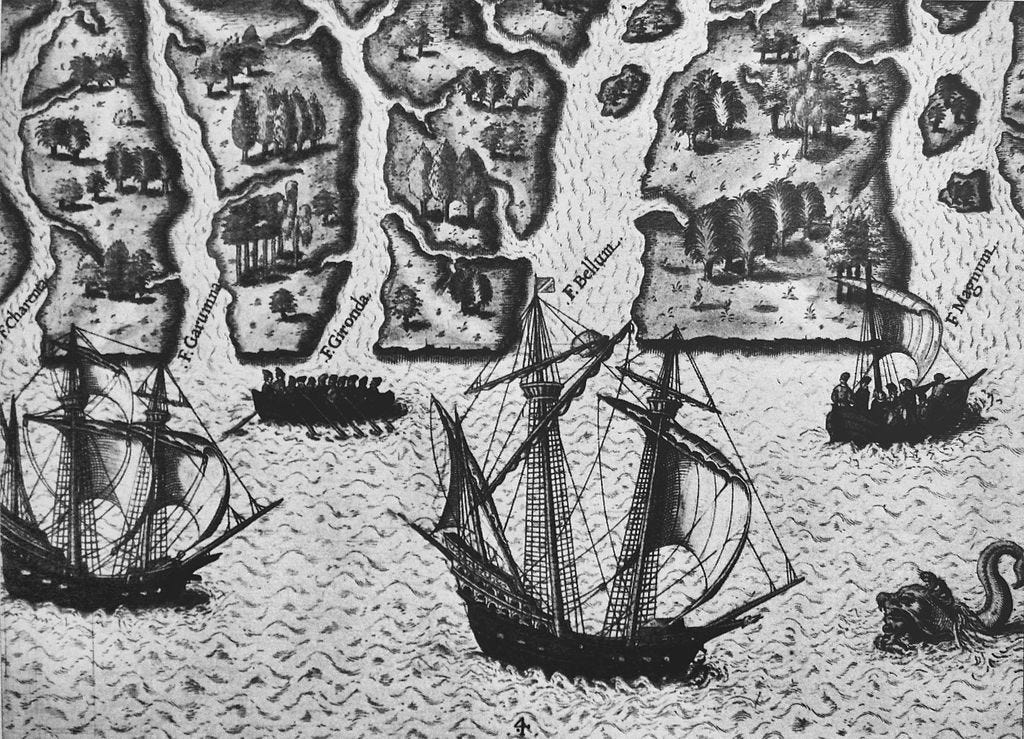
In the decades since this misconception of early Spanish history of the area, numerous archaeological excavations have clarified just how dynamic Santa Elena’s history was. Settlers there were members of all classes of society, including nobility. Archaeologists have found Spanish and Native American artifacts mixed together, along with “trade goods from as far away as China, suggesting an interconnected society.”
In the Coastal Discovery Museum's upcoming exhibit, visitors will be able to view the remains of this rich history of the Santa Elena settlement, including a 3D Digital Interactive exhibit that reconstructs the original Fort San Marcos. See the video below too!
The exhibition will also display found artifacts, such as cloth embroidered with gold that was worn by nobleman of the settlement, as well as pottery vessels, and fragments of horseshoes that explain the presence of “Marsh Tacky” horses that now run wild on Hilton Head Island — and were brought over by the Spanish centuries earlier. The exhibit will also feature a dugout canoe that once belonged to Native Americans local to the area, and highlights the “interconnected trading routes and the importance of the many tangled waterways together to this day.”
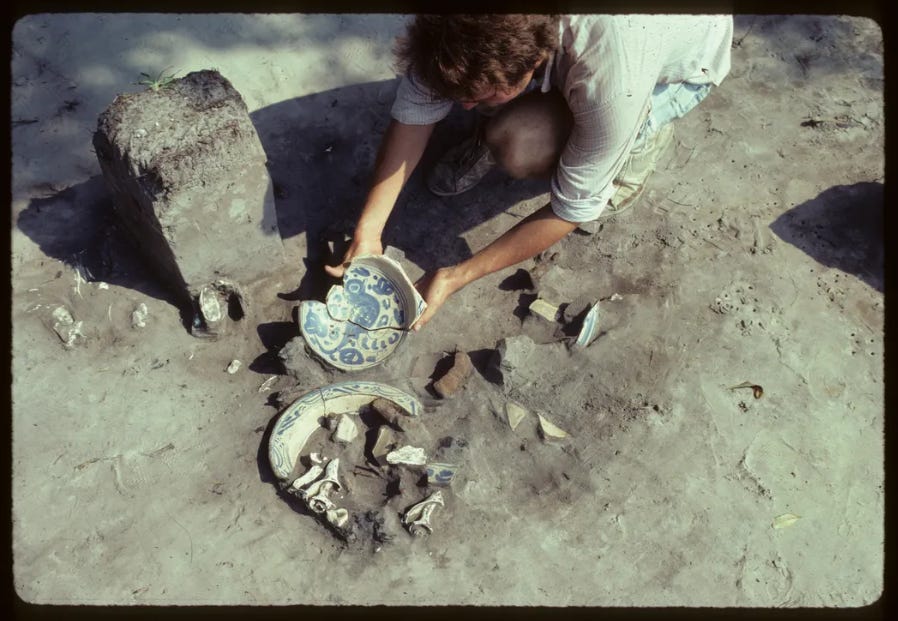

Additionally, the exhibit will show how in 2016, using remote mapping technology, archaeologists were able to map the 16th century town of Santa Elena and identify where buildings, churches, and plazas would have stood.
The Smithsonian Magazine article sums it up well that the history of Santa Elena was “a rich amalgam of religion, geopolitics, cultural clashes, wars, and survival.”
At the height of the settlement, Santa Elena constituted around 60 dwellings and a population of approximately 450 to 500 people. But even with modern research, this still remains a “relatively obscure chapter” of South Carolina history.
In the Smithsonian article, Rex Garniewicz makes more thought-provoking points below on the legacy of Santa Elena:
“It's the first colonial capital, so it is a colonial story—but there were people who were here not by choice. There were enslaved people here; there were also Native people who were sophisticated traders, and who eventually forced the Spanish out of the area… There are a lot of different groups that influenced the evolution of American culture and American ideals. As a predominantly English-speaking country, we often underestimate the impact that Native peoples, France, and Spain had on the founding of our country. The first European language spoken here, at the first capital, was Spanish. Settlers were eating Spanish foods, drinking Spanish wine, and wearing Spanish clothes. And now, we see this group that many consider as new immigrants to this country—but their ancestors have a deep history here."
The Santa Elena exhibition at the Coastal Discovery Museum will be mounted in 2025 and the specific dates will be announced soon. In fact, the museum is renovating its current structure to accommodate the new exhibition and create a rich experience for those who visit. I look forward to featuring this exhibition in the newsletter when the dates are officially announced!
Do you have additional knowledge or insights into these first Spanish settlements of South Carolina? Leave a comment below!
➳ SC History Quote of the Week
"The Spaniards have visited several regions of that vast country; they are called Arambe, Guacaia, Quohathe, Tazacca, and Tahor. The colour of the inhabitants is dark brown. None of them have any system of writing, but they preserve traditions of great antiquity in rhymes and chants. Dancing and physical exercises are held in honour, and they are passionately fond of ball games, in which they exhibit the greatest skill. The women know how to spin and sew. Although they are partially clothed with skins of wild beasts, they use cotton such as the Milanese call bombasio, and they make nets of the fibre of certain tough grasses just as hemp and flax are used for the same purposes in Europe.”
—Further excerpts from the writings of Peter Martyr in De Orbe Novo and “The Testimony of Francisco de Chicora” from 1530.
➳ St. Helena Article Sources
"Chicora, Francisco de." South Carolina Encyclopedia, www.scencyclopedia.org/sce/entries/chicora-francisco-de/. Accessed 9 August 2024.
"Lucas Vázquez de Ayllón." The Catholic Encyclopedia, www.newadvent.org/cathen/04069c.htm. Accessed 9 August 2024.
"Peter Martyr d'Anghiera." Wikipedia, en.wikipedia.org/wiki/Peter_Martyr_d%27Anghiera. Accessed 9 August 2024.
"San Miguel de Gualdape." South Carolina Encyclopedia, www.scencyclopedia.org/sce/entries/san-miguel-de-gualdape/. Accessed 9 August 2024.
"Santa Elena: The 1500s Capital of Spanish Florida." National Park Service, www.nps.gov/articles/santa-elena-the-1500s-capital-of-spanish-florida.htm. Accessed 9 August 2024.
"St. Helena." The Catholic Encyclopedia. Vol. 7, New York: Robert Appleton Company, 1910. New Advent, http://www.newadvent.org/cathen/07202b.htm. Accessed 9 August 2024.
"St. Helena Island." Visit Beaufort South Carolina, www.beaufortsc.org/islands-and-towns/st-helena-island/. Accessed 9 August 2024.
"The Natives are White Men: An Excerpt from De Orbe Novo by Peter Martyr d'Anghiera, 1530." Encyclopedia Virginia, encyclopediavirginia.org/primary-documents/the-natives-are-white-men-an-excerpt-from-de-orbe-novo-by-peter-martyr-danghiera-1530/. Accessed 9 August 2024.
"Uncover the Surprising History of Hilton Head Island’s 16th-Century Capital." Smithsonian Magazine, www.smithsonianmag.com/sponsored/uncover-the-surprising-history-of-hilton-head-islands-16th-century-capital-180984097/?utm_medium=social&utm_source=facebook&utm_campaign=spons&utm_content=HHI&kwp_0=2372953&kwp_4=6656650&kwp_1=2840163. Accessed 9 August 2024.
"Vázquez de Ayllón, Lucas." South Carolina Encyclopedia, www.scencyclopedia.org/sce/entries/ayllon-lucas-vasquez-de/. Accessed 9 August 2024.
I always want to improve my work. Answer the poll below to give me your review of today’s newsletter. I also welcome your suggestions for new content! Simply reply to this email with your ideas. Thank you!














